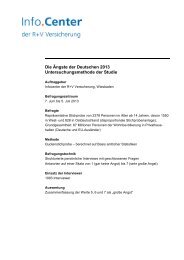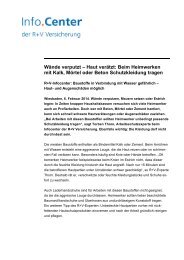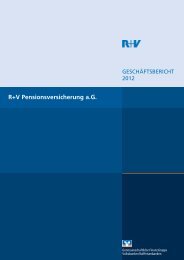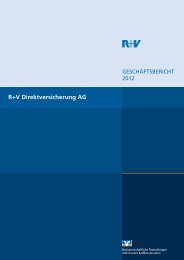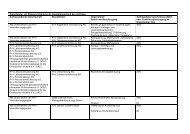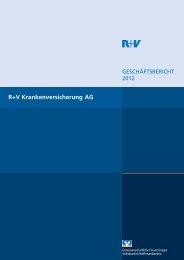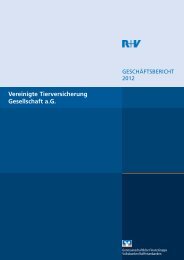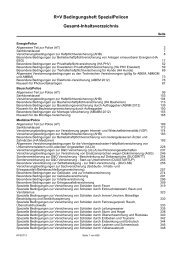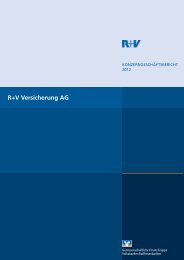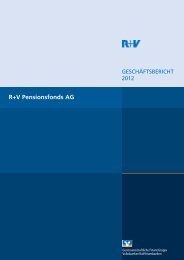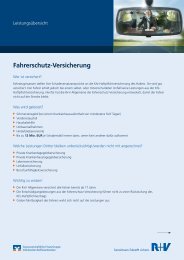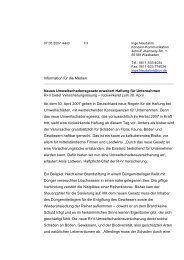Annual Report 2011 - R+V Versicherung
Annual Report 2011 - R+V Versicherung
Annual Report 2011 - R+V Versicherung
You also want an ePaper? Increase the reach of your titles
YUMPU automatically turns print PDFs into web optimized ePapers that Google loves.
Management <strong>Report</strong> 4<br />
gency management activities at <strong>R+V</strong> and reports to the <strong>R+V</strong><br />
risk conference on significant findings and on the emergency<br />
exercises carried out.<br />
Business continuity management guarantees that the business<br />
operations of <strong>R+V</strong> <strong>Versicherung</strong> AG can be sustained in the<br />
event of a crisis. The business processes necessary for this are<br />
identified and supported with personnel resources within the<br />
context of emergency planning.<br />
The risk inventory that is taken once a year encompasses the<br />
entire risk management of <strong>R+V</strong>. The purpose of the risk inventory<br />
is reviewing and documenting all known individual and<br />
cumulative risks as well as the risk bearing ability and the<br />
business continuity management system. The indicators and<br />
threshold values used are also reviewed here.<br />
Compliance with the regulations of the risk management<br />
system and its effectiveness is examined by the Group Audit<br />
department. Measures are agreed to rectify any deficits that<br />
are identified and are followed up regularly by Group Audit.<br />
Technical risks<br />
The technical risk describes the risk by which the actual<br />
expenditure on losses and services differs from expected<br />
expenditure due to accident, error or change.<br />
The main technical risks for a reinsurer are in portfolios endangered<br />
by natural disasters and in fundamental changes in<br />
trends in its main markets.<br />
<strong>R+V</strong> <strong>Versicherung</strong> AG counters these risks by continually<br />
observing the market. Particular importance is attached to a<br />
balanced portfolio in terms of both geographical diversification<br />
and the mix of classes of insurance. Risk control is carried<br />
out through a clearly structured earnings-oriented underwriting<br />
policy. Risks are assumed within binding underwriting<br />
guidelines and limits which restrict liability both in individual<br />
and cumulative loss and within clear underwriting mandates.<br />
Compliance with these stipulations is reviewed regularly.<br />
Supplementary report / Risk report<br />
<strong>Annual</strong> Financial Statements 35 Further Information 62 23<br />
The actual and possible impact of losses caused by disasters<br />
with regard to their extent and frequency is continually<br />
recorded and tracked using standard industry software<br />
supplemented by in-house verification.<br />
An important risk management tool is systematic cumulative<br />
control i.e. checking the possible accumulation of losses from<br />
one loss event. Cumulative risks, such as those resulting from<br />
a natural disaster, are controlled centrally. The technical provisions<br />
are set appropriately.<br />
Risk reduction measures are utilised. The management of<br />
insurance excesses and of retrocession is done by taking risk<br />
bearing capacity and the effective retrocession costs into<br />
account. There are minimum creditworthiness requirements<br />
for retrocessionaires. The risk bearing capacity of <strong>R+V</strong> <strong>Versicherung</strong><br />
AG is created through adequate capital resources<br />
and reserves and consequently there is currently no retrocession<br />
purchasing due to the high costs of retrocession protection.<br />
Loss development in <strong>2011</strong> was characterised by an extremely<br />
strong impact from large losses. The largest losses resulted<br />
primarily from natural disasters, such as the loss events from<br />
the earthquakes in Japan, Christchurch in New Zealand and<br />
the flood disaster in Thailand. Following the exceptional year<br />
in <strong>2011</strong>, business development envisages a return to positive<br />
results with a combined ratio of < 100%. Various measures<br />
contributed towards an increase in profitability. These included<br />
price increases and a reduction in volatility, for example,<br />
selective underwriting of earthquake risks. In addition, the<br />
equalisation provision serves to compensate accidental fluctuations<br />
in the loss area over the course of time.<br />
Financial instrument risks<br />
Within the framework of providing insurance cover for customers,<br />
insurance companies see themselves as exposed to<br />
specific market, credit, liquidity and concentration risks.<br />
These could lead to a permanent loss of the value of capital<br />
investments and – in the final analysis – to endangering the



